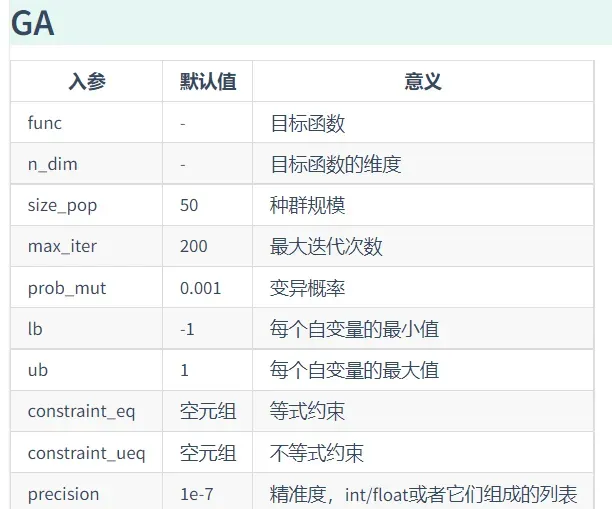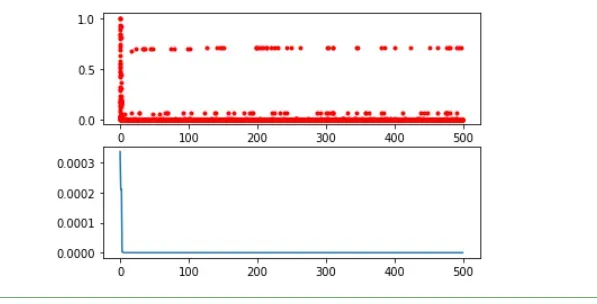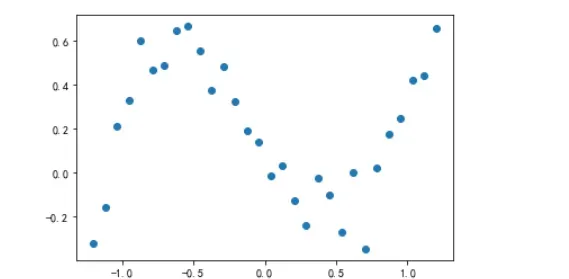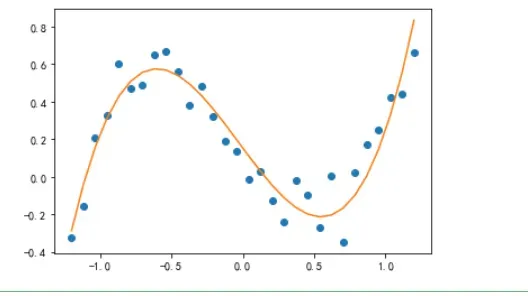遗传算法概念
基本思想:
- 遗传算法(GA)是一种全局寻优搜索算法,它依据的是大自然生物进化过程中“适者生存”的规律。它首先对问题的可行解进行编码,组成染色体,然后通过模拟自然界的进化过程,对初始种群中的染色体进行选择、交叉和变异,通过一代代进化来找出最优适应值的染色体来解决问题。
- 遗传算法是从代表问题可能潜在的解集的一个种群(population)开始的,而一个种群则由经过基因(gene)编码的一定数目的个体(individual)组成。因此,第一步需要实现从表现型到基因型的映射即编码工作。初代种群产生之后,按照适者生存和优胜劣汰的原理,逐代(generation)演化产生出越来越好的近似解,在每一代,根据问题域中个体的适应度(fitness)大小选择个体,幵借助于自然遗传学的遗传算子(genetic operators)进行组合交叉和变异,产生出代表新的解集的种群。这个过程将导致种群像自然进化一样,后生代种群比前代更加适应于环境,末代种群中的最优个体经过解码(decoding),可以作为问题近似最优解。
算子
选择算子:轮盘选择(roulette wheel selection)、排序选择(rank-based selection)、锦标赛选择(Tournament selection);
交叉算子:单点交叉(Single-point crossover)、k点交叉(K-point crossover)、均匀交叉(Uniform crossover)等;
变异算子:位翻转突变(Flip bit mutation)、交换突变、反转突变(Swap mutation)等。
实数编码染色体的遗传算子:用于处理解空间连续问,也即个体由实数(浮点数)组成。混合交叉、模拟二进制交叉、实数突变。选择操作不受影响
快速开始
参数说明
输入:

输出:
- ga.generation_best_Y 每一代的最优函数值
- ga.generation_best_X 每一代的最优函数值对应的输入值
- ga.all_history_FitV 每一代的每个个体的适应度
- ga.all_history_Y 每一代每个个体的函数值
- ga.best_y 最优函数值
- ga.best_x 最优函数值对应的输入值
- Y_history.index 迭代的当前次数(索引)
定义目标
import numpy as np
def schaffer(p):
x1, x2 = p
# x=sqe(x1)+sqr(x2)
x = np.square(x1) + np.square(x2)
# 0.5+((ser(sinx)-0.5) / sqr(1.0.001)*x)
return 0.5 + (np.square(np.sin(x)) - 0.5) / np.square(1 + 0.001 * x)
运行遗传算法
from sko.GA import GA
ga = GA(func=schaffer, n_dim=2, size_pop=50, max_iter=500, prob_mut=0.001, precision=1e-7)
best_x, best_y = ga.run()
print('best_x:', best_x, '\n', 'best_y:', best_y)
# 把结果带回去测试一下
如下:
best_x: [-9.83476668e-07 -2.98023233e-08]
best_y: [8.8817842e-16]
注:最优解为最小值,若要求最大值,需要在前面加负号
可视化
import pandas as pd
import matplotlib.pyplot as plt
Y_history = pd.DataFrame(ga.all_history_Y)
fig, ax = plt.subplots(2, 1)
ax[0].plot(Y_history.index, Y_history.values, '.', color='red')
Y_history.min(axis=1).cummin().plot(kind='line')
plt.show()
如下:

整数规划
在多维优化时,想让哪个变量限制为整数,就设定 precision 为 整数 即可。例如,我想让我的自定义函数 demo_func 的某些变量限制为整数+浮点数(分别是隔2个,隔1个,浮点数),那么就设定 precision=[2, 1, 1e-7]
例子如下:
from sko.GA import GA
demo_func = lambda x: (x[0] - 1) ** 2 + (x[1] - 0.05) ** 2 + x[2] ** 2
ga = GA(func=demo_func, n_dim=3, max_iter=500, lb=[-1, -1, -1], ub=[5, 1, 1], precision=[2, 1, 1e-7])
best_x, best_y = ga.run()
print('best_x:', best_x, '\n', 'best_y:', best_y)
如下:
best_x: [1.00000000e+00 0.00000000e+00 2.98023233e-08]
best_y: [0.0025]
说明:
- 当 precision 为整数时,对应的自变量会启用整数规划模式。
- 在整数规划模式下,变量的取值可能个数最好是
,这样收敛速度快,效果好。
- 如果 precision 不是整数(例如是0.5),则不会进入整数规划模式,如果还想用这个模式,那么把对应自变量乘以2,这样 precision 就是整数了。
案例一:最值
题目:用标准遗传算法求函数f(x)=x+10sin(5x)+7cos(4x) 的最大值。
import numpy as np
# f(x)=x+10sin(5x)+7cos(4x)
def schaffer(p):
x1, x2 = p
return x2+10*np.sin(5*x1)+7*np.cos(4*x2)
from sko.GA import GA
ga = GA(func=schaffer, n_dim=2, size_pop=50, max_iter=500, prob_mut=0.001, precision=1e-7)
best_x, best_y = ga.run()
print('x最佳值:', best_x, '\n', '最大值:', -best_y)
import pandas as pd
import matplotlib.pyplot as plt
Y_history = pd.DataFrame(ga.all_history_FitV ) #每一代的适应度
plt.rcParams['font.sans-serif']=['SimHei'] #用来正常显示中文标签
plt.rcParams['axes.unicode_minus']=False #用来正常显示负号
plt.xlabel("迭代次数")
plt.ylabel("适应度")
plt.title("适应度变化")
plt.plot(Y_history.index, Y_history.values, '.', color='red')
如下:

history = pd.DataFrame(ga.all_history_Y)
plt.plot(Y_history.index, history.values, '.', color='red')
history.min().cummin().plot(kind='line')
plt.show()

案例二:机器学习
以机器学习中鸢尾花的逻辑回归为例:
from sklearn.datasets import load_iris
from sklearn.linear_model import LogisticRegression
from sklearn.model_selection import train_test_split
iris = load_iris()
xtrain,xtest,ytrain,ytest = train_test_split(iris['data'],iris['target'],test_size=0.2)
def func(p):
w1, w2 = p
clf = LogisticRegression(max_iter=int(w1), random_state=int(w2))
clf.fit(xtrain,ytrain)
score = clf.score(xtest,ytest)
return -score #由于这里的GA默认求得最小值,而我们想要score达到最大值,因此需要在score前加负号
ga = GA(func=func, n_dim=2, size_pop=50, max_iter=10, lb=[0, 0],ub=[3, 10],precision=1e-7)
best_x,best_y = ga.run()
print('best_x:', best_x,'\n','best_y:',best_y)
案例三:曲线拟合优化
产生x和y点:
import numpy as np
import matplotlib.pyplot as plt
from sko.GA import GA
x_true = np.linspace(-1.2, 1.2, 30)
y_true = x_true ** 3 - x_true + 0.4 * np.random.rand(30)
plt.plot(x_true, y_true, 'o')
如图:

构造参差:
def f_fun(x, a, b, c, d):
# y=a*x^2+b*x+c*x+d
return a * x ** 3 + b * x ** 2 + c * x + d
def obj_fun(p):
# 四个参数,abcd
a, b, c, d = p
# 目标为残差
residuals = np.square(f_fun(x_true, a, b, c, d) - y_true).sum()
return residuals
如下:
best_x: [ 1.03756528 0.08383939 -1.02735888 0.15224675]
best_y: [0.3521411]
拟合:
y_predict = f_fun(x_true, *best_params)
fig, ax = plt.subplots()
ax.plot(x_true, y_true, 'o')
ax.plot(x_true, y_predict, '-')
plt.show()
如下:

参考
https://scikit-opt.github.io/scikit-opt/#/zh/curve_fitting
文章出处登录后可见!
已经登录?立即刷新
